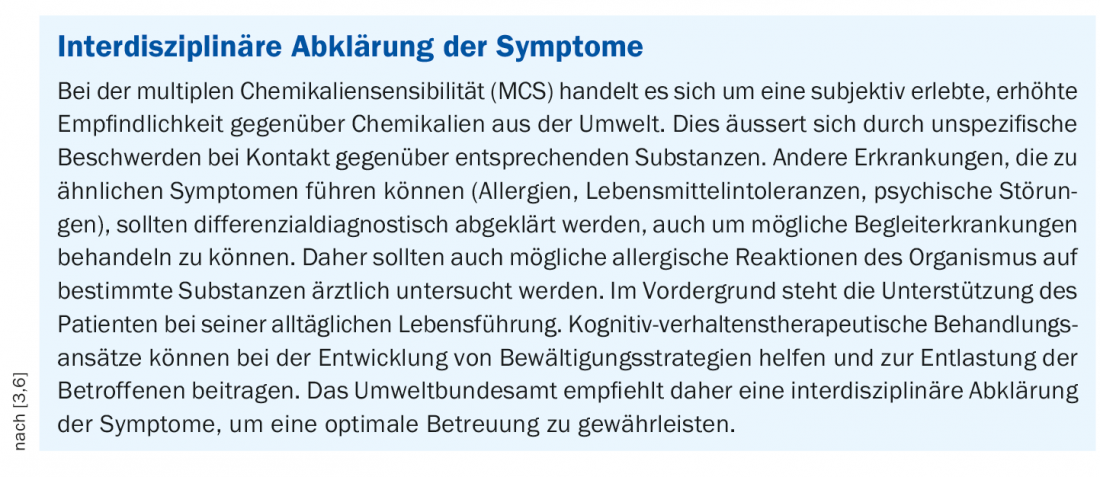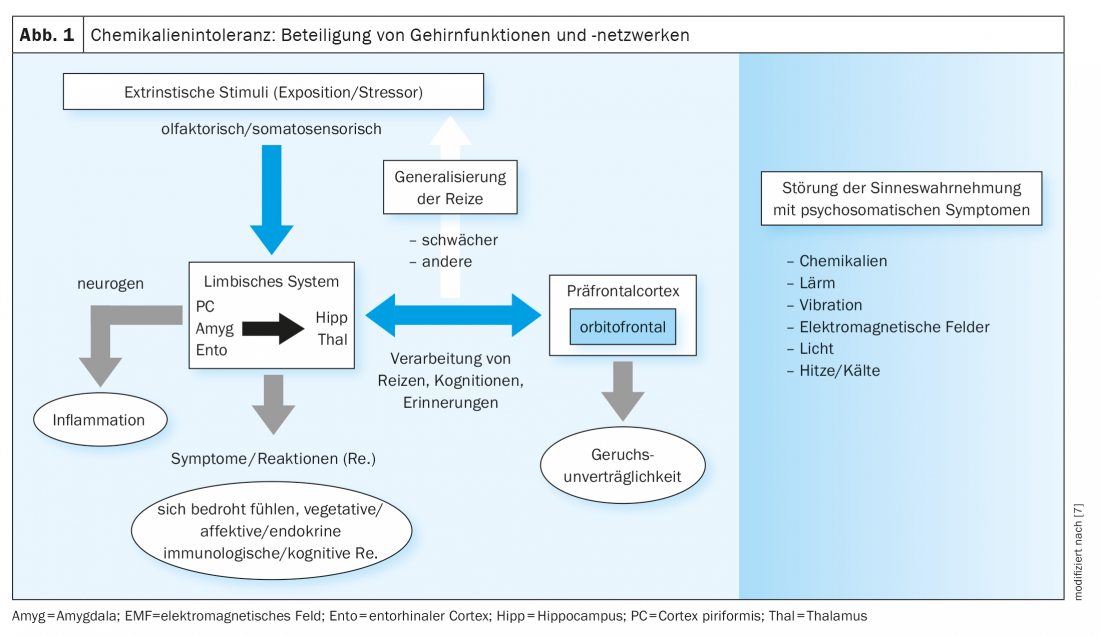Multiple Chemical Sensitivity” (MCS) is a subjectively experienced increased sensitivity to chemicals from the environment. Affected persons react with a variety of non-specific complaints. The level of suffering can be very high. Differential diagnosis is to exclude other possible causes for the symptoms, including allergies, . Where MCS can also occur as a comorbidity.
General symptoms such as fatigue, exhaustion, respiratory problems, gastrointestinal symptoms, and other disorders of various organ systems are associated by affected individuals with exposure to various chemicals and environmental exposures [1–3]. Chemicals include, in particular, wood preservatives, solvents, insecticides, heavy metals, disinfectants and fragrances. The symptoms are already triggered by very low concentrations that do not cause any reactions in healthy people [1–3]. Thresholds are very individual and not generally known. Symptoms such as itching, burning skin, dry mouth, or feelings of anxiety may also occur [1–3].
It remains unclear whether MCS is a disease entity in its own right [3]. It is clear that psychosomatic stress often occurs together with MCS complaints. However, it is uncertain whether in the case of such comorbidity, the MCS symptoms are the cause or the consequence of psychosomatic complaints.
Exposure prevention as most important measure
Bartha et al. have noted the following consensus criteria for defining MCS [4]:
- Symptoms are reproducible with repeated chemical exposures.
- The condition is chronic.
- Symptoms are triggered by low levels of exposure that are generally tolerated by others or were tolerated before the onset of the disease.
- Symptoms improve or disappear completely when the triggers are avoided or removed.
- Symptoms are triggered by various chemically unrelated substances.
- Multiple organs or organ systems are affected by symptoms.
a) MCS should also be diagnosed alongside other diagnoses that partially lead to fulfillment of criteria 1 to 6 (asthma, allergies, migraine).
b) Exclusion of MCS: The reported complaints can be fully explained (full spectrum) by a known disease of the patient.

The personal consequences of MCS are – just like the symptoms – manifold. Affected individuals report, among other things, limitations in quality of life and performance and often find themselves unable to perform their jobs [3]. Doing everyday chores and socializing with friends and family are also often experienced as problematic and conflictual. The suffering of MCS patients can be very high and in extreme cases can even lead to social isolation. It is recommended to initiate interdisciplinary clarifications (box).

To date, it has not been conclusively clarified whether, and if so, which mechanisms are involved in the development of MCS. A wide variety of etiological processes have been proposed, which can be classified as disorders of immunological or allergic processes, modifications of the function of the nervous system, deviations from the norm of biochemical processes, or changes in psychological or neurobehavioral functions [5]. A 2019 publication in the Journal Environmental Health and Preventive Medicine proposed an explanatory model showing possible links between sensory inputs and neural processing pathways in MCS (Fig. 1) [7]. The authors included in their secondary analysis data from 23 studies published in peer-reviewed journals between 2000-2019.
Literature:
- Harth W, Gieler U: Multiple-chemical-sensitivity syndrome (MCS). In: Harth W, Gieler U (eds.): Psychosomatic Dermatology. Heidelberg: Springer Medizin Verlag, 2006: 43.
- Rossi S, Pitidis A: Multiple Chemical Sensitivity: Review of the state of the art in epidemiology, diagnosis, and future perspectives. J Occup Environ Med 2018; 60(2): 138-146.
- “Multiple Chemical Sensitivity,” Federal Environmental Agency, Dec. 15, 2021, www.umweltbundesamt.de (last accessed Aug. 15, 2022).
- Bartha L, et al: Multiple chemical sensitivity: a 1999 consensus. Arch Environ Health 1999; 54(3): 147-149.
- Winder C: Mechanisms of multiple chemical sensitivity. Toxicology letters 2002; 128(1): 85-97.
- Harter K, et al: Multiple chemical sensitivity (MCS) – A dermatology guide to the management of affected individuals. J Dtsch Dermatol Ges 2020; 18(2): 119-131.
- Azuma K, et al: Chemical intolerance: involvement of brain function and networks after exposure to extrinsic stimuli perceived as hazardous. Environ Health Prev Med 2019; 24(1): 61.
HAUSARZT PRAXIS 2022; 17(8): 4-5
CARDIOVASC 2022; 21(3): 42











